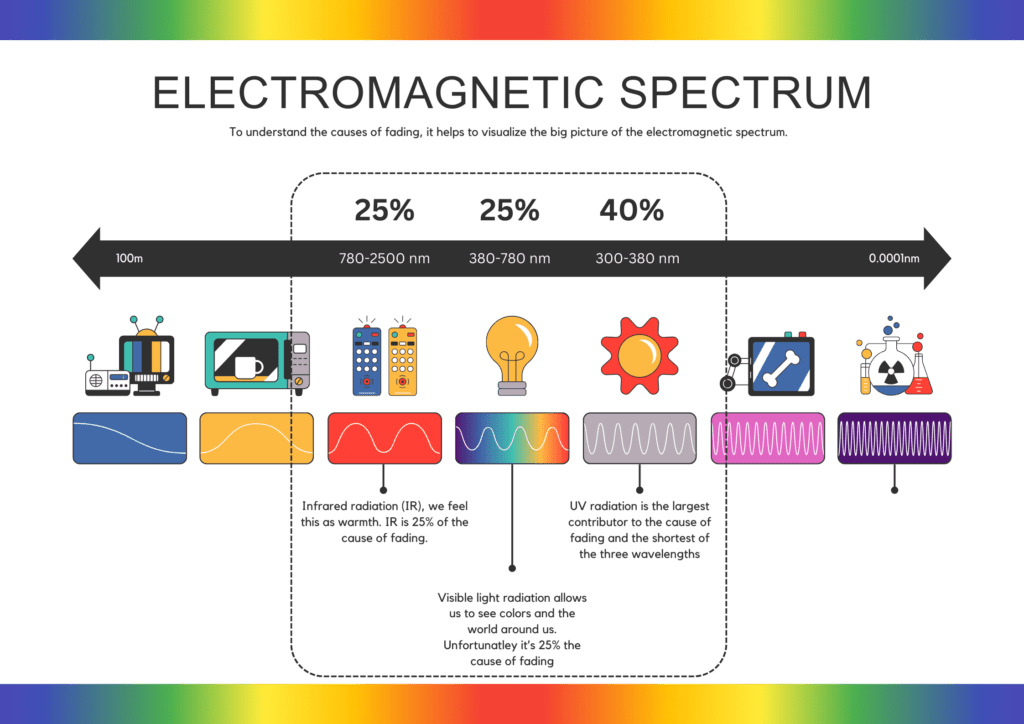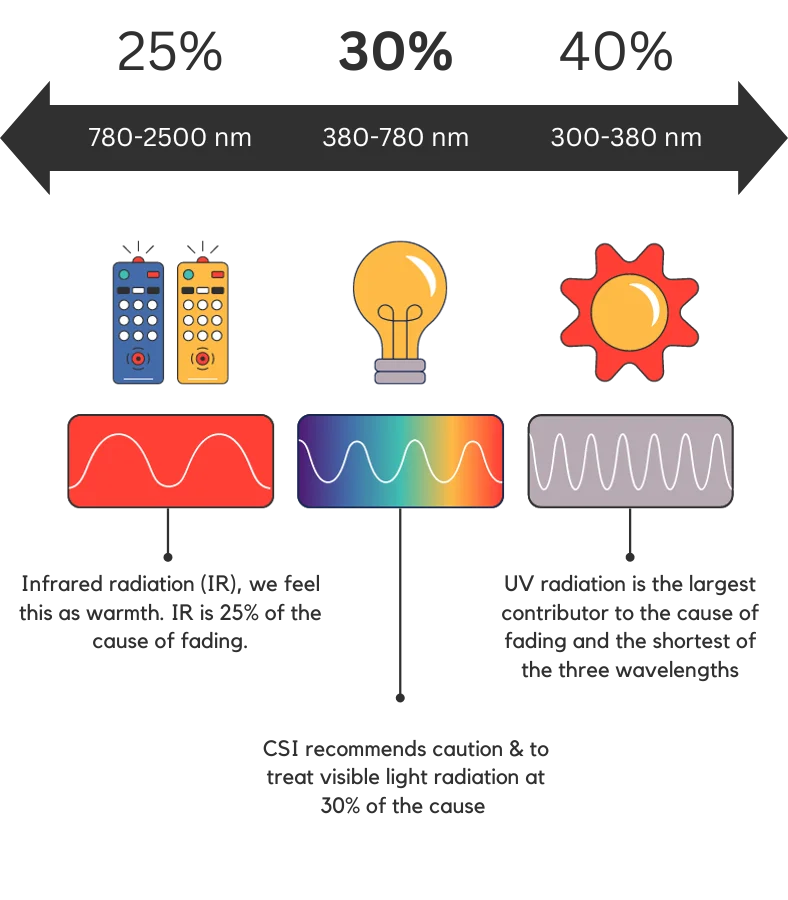Furniture fading is a common issue in homes and businesses, often caused by prolonged exposure to sunlight. We will explore the causes of furniture fading per industry standards compared to our real world observations over the 22+ years in business and how UV window film, like those offered by Clearview Sun Control, Inc., can be an effective solution.
To comprehend the reasons behind the fading of objects, it is essential to understand the broader perspective of the electromagnetic spectrum. This spectrum is the range of all types of electromagnetic radiation, including everything from x-rays to radio waves. However, for our discussion on fading, we will focus on three particular types of radiation – Ultraviolet (UV), Visible Light and Infrared (IR).
Main Causes of Fading:
UV Radiation
Ultraviolet radiation (UV), is the largest contributor to the cause of fading, accounting for about 40% of it. UV radiation ranges from 300-380 nm on the electromagnetic spectrum. It is the shortest of the three wavelengths we are discussing here. Although UV radiation is essential for the production of vitamin D in our bodies, it is detrimental to materials, especially those left in direct sunlight. The high energy of UV radiation can break down chemical bonds, leading to fading and degradation of materials.
Quick fact check about U/V Radiation:
- Consists of U/V rays A, B & C. A causes wrinkles, B causes Skin Cancer, C is most destructive but little reaches earth because it’s mostly absorbed by the earths ozone layer.
Visible Light Radiation
Visible light radiation is the part of the electromagnetic spectrum that allows us to see colors and the world around us. It ranges from 380-780 nm. However, paradoxically, the very light that enables us to see things is also a contributor to their fading. Visible light accounts for around 25% of the causes of fading. The continuous exposure of materials to visible light can lead to photo-degradation, which is a chemical change that results in discoloration and fading.
Infrared Radiation (IR)
Infrared radiation (IR) is a type of electromagnetic radiation that is invisible to the human eye but can be felt as warmth. On the electromagnetic spectrum, it ranges between 780-2500 nm. Despite the comfort it provides, IR is also a contributor to fading, accounting for about 25% of its causes. This is because IR can heat up objects, causing them to expand and contract, leading to a weakening of their materials and eventual fading.
Quality of Furniture Materials (other):
Last but not least, the rate of fading can depend on the type of materials used in your furniture. Certain fabrics and dyes are more susceptible to fading. This along with some other factors are known to cause the final 10%.
Short Technical Break:
As we have learned, energy waves have different degrees of activity. What’s important to know is that the UV waves are the most destructive of the three energy waves of interest. They are measured in nanometers (nm) and take up 300-380 nm. The lower this number the higher the destruction (a lower number is synonymous to shorter wavelengths), e.g. ‘gamma rays’ are within .01 – .0001 nm.
note: it’s important to understand that the IR spectrum is in the range of 780-2500 nm because 3M window film advertises on their spec sheets up to 97% IR rejection films within a ‘900-1000 nm’ range whereas IR covers a much wider range. This has caused major confusion for our customers. Additionally, 3M also uses ‘non standard’ technical terms such as ’60 degree angle’ readings. No other major manufacturer that we deal with uses such terms so it’s impossible to compare apples to apples. This is public information they provide readily on the internet as of Jan 8, 2024.

CSI’s recommendation for fade control
Over the years and along with the latest glass measuring tools, Clearview Sun Control, Inc. has observed that the visible light spectrum ‘appears’ to have a stronger correlation to fading than what our industry suggests. This makes sense technically to us because visible light by definition has a shorter wavelength than infrared radiation and we know that shorter wavelengths are more destructive than their longer wavelength counterparts. We are not scientists nor mathematicians so we want to make it clear that this is our observation only.
So for most of CSI’s existence our professional recommendation has been to choose caution, a film no lighter than 50% vlt (visible light transmission) is our recommendation for optimal fade protection. A 50% vlt is still considered a light product, as a comparison, a medium shaded film is around 35% vlt which will perform much better for fade reduction than a 50% vlt solar film. Ask for a live demonstration during our visit.
An important factor to consider is our ‘visual light perception‘, a complex but beautifully orchestrated process that starts with light entering our eyes and ends with our brain creating a visual image. You may be shocked to learn about what our eyes/brain perceive as light compared to technical spec’s, hint, our perception of visible light is much higher than you would even imagine.
Therefore, for the ultimate in managing fade control of your furniture and heirlooms we recommend to change the status quo to:
Our Updated, ‘What Causes Fading’ Graph:
40% UV (Ultraviolet Radiation)
30% Visible Light Radiation
25% IR (Infrared Radiation)
5% other

Clearview Sun Control, Inc. is located in Redondo Beach, CA., we have been serving Manhattan Beach, Hermosa Beach, Rancho Palos Verdes, San Pedro and surrounding areas within a 100 mile radius since 2001, lic #774678.